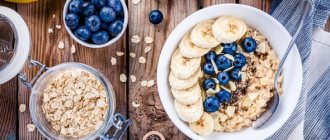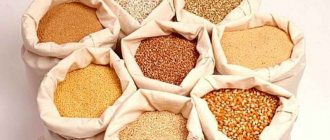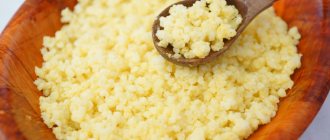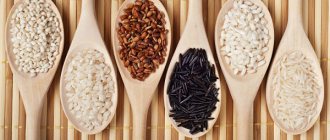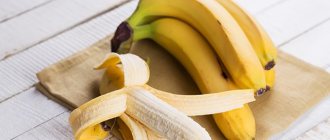Diabetes mellitus requires strict adherence to a special diet. For the menu to be not only healthy, but also nutritious, the diet should include porridge. Corn is considered one of the most delicious and healthy cereals for diabetics. Properly prepared corn porridge for diabetes will please not only the stomach - with moderate consumption of the product, you don’t have to worry about sudden surges in blood sugar.
Corn porridge for type 2 diabetes: benefits and harms
Brightly colored corn kernels are not only beautiful, but also very healthy, as they contain many vitamins: C, E, K, D, PP, as well as B vitamins, magnesium, potassium and phosphorus.
Eating corn reduces the likelihood of developing diabetes, cardiovascular disease and stroke. It is noted that it has a beneficial effect on metabolism and helps reduce blood glucose levels. For example, corn porridge contains amylose, a substance that slows down the penetration of sugar into the blood, and a decoction of the hairs enveloping the cob can completely reduce its level. Corn bran has antioxidant properties. Corn porridge satisfies perfectly and for a long time, which is very important for diabetics fighting excess weight.
“Queen of the Fields” on guard of health
You should eat corn at least once a week. The only thing that doctors do not advise doing is to overuse products from this cereal if you have diseases of the digestive system (corn takes a long time to digest and can cause bloating) and the presence of blood clots (contains substances that increase blood clotting).
Corn starch can cause harm, but this is only possible if there is an individual intolerance to the culture itself, which is quite rare and manifests itself in the form of a severe allergic reaction, asthma and rashes on the skin.
Millet for type 2 diabetes mellitus is a useful product, the use of which is recommended to patients by doctors. People with diabetes have a difficult time when it comes to food. The slightest disturbance in eating and your health deteriorates sharply.
What doctors say about diabetes
Doctor of Medical Sciences, Professor Aronova S. M.
I have been studying the problem of DIABETES for many years. It's scary when so many people die and even more become disabled due to diabetes.
I hasten to announce the good news - the Endocrinological Research Center of the Russian Academy of Medical Sciences managed to develop a medicine that completely cures diabetes mellitus. At the moment, the effectiveness of this drug is approaching 100%.
Another good news: the Ministry of Health has achieved the adoption of a special program under which the entire cost of the drug is compensated. In Russia and the CIS countries, diabetics can receive the product for FREE.
For type 2 diabetes, the main treatment consists of diet therapy, that is, special nutrition. Properly selected products will not affect the increase in blood sugar, thereby improving the patient’s condition.
The endocrinologist gives general information about the diet, but the patient must learn the basic principles of food selection himself. The main criterion is the glycemic index (GI). A diabetic's diet must include vegetables, fruits, animal products and cereals. The choice of porridge should be approached with special care, because some have a high GI and contain many bread units (XE), and their consumption is limited in case of diabetes of any type.
Below we will consider whether it is possible to eat corn grits if you have type 2 diabetes, what its GI is and how many bread units it contains. Recommendations on proper preparation are also given.
Diet therapy is based on foods with a low GI and a small content of bread units. GI is a measure of the effect of a particular food on blood glucose levels after consumption.
For diabetics, the allowed values are up to 50 units - these form the main diet; food with an average index is acceptable several times a week, but high GI is strictly prohibited. If you consume foods with a high index, they can provoke hyperglycemia or the transition of type 2 diabetes to the insulin-dependent type.
The consistency of the finished dish affects the increase in the GI of cereals - the thicker the porridge, the higher its GI. It is forbidden to add butter and margarine to porridge; it is better to replace them with vegetable oil.
GI division scale:
- up to 50 units – products for the main diet;
- 50 – 70 IU – food can only occasionally be included in the diet;
- from 70 IU - such food can provoke hyperglycemia.
Corn grits have a GI of 80 units, which puts its benefits in diabetes into great doubt. Of course, such porridge is quite healthy, as it contains many vitamins and microelements.
Benefit
In many countries, corn is considered a panacea for various diseases. All this is due to the presence of a variety of vitamins and micro- and macroelements in it. As a therapeutic therapy, I prescribe corn silk extract for diabetics, which after a month’s use lowers blood sugar levels.
This cereal has earned a high GI due to its high content of easily digestible carbohydrates. Although its calorie content is relatively low, which is why dishes made from it are included in many diets.
For diabetes and other diseases, corn porridge can suppress intestinal putrefactive processes in the body. It also promotes the removal of fats and accumulated pesticides.
Useful substances in corn porridge:
- vitamin A;
- B vitamins;
- vitamin E;
- vitamin PP;
- phosphorus;
- potassium;
- silicon;
- calcium;
- iron;
- chromium.
Vitamin A increases the body's resistance to various infections. Vitamin E improves the condition of hair and skin. The content of increased amounts of phosphorus in this cereal has a beneficial effect on the functioning of the nervous system. Silicon normalizes the functioning of the gastrointestinal tract.
Cooking corn porridge for type 2 diabetes requires water until it has a viscous consistency. Corn grits contain dietary fiber, which normalizes cholesterol in the blood.
This porridge should be prepared in proportions of one to two, that is, 200 ml of water is taken per 100 grams of cereal. It is cooked over low heat for at least 25 minutes. After finishing cooking, it is recommended to season this side dish with vegetable oil.
You can use olive oil, after infusing it with herbs and vegetables (chili peppers, garlic). Oil is poured into a dry glass container and herbs (cumin, basil) and garlic are added. This oil should be infused in a cool, dark place for at least a day.
The use of dairy products in the preparation of corn porridge is prohibited. Its GI is higher than the permissible norm for a diabetic, and the use of milk will only increase this value. The question arises: how much of this porridge can a person with diabetes eat? A serving should not exceed 150 grams, the presence of a side dish in the diet no more than twice a week.
This side dish will go well with the following dishes:
- chicken liver with gravy;
- steamed beef cutlets;
- chicken breast stewed in tomato;
- fish cutlets.
The first recipe for corn porridge involves cooking the porridge in a slow cooker. All ingredients should be measured according to the multi-cup that comes with the multicooker. You will need a glass of cereal, two glasses of skim milk and a glass of water, a handful of dried apricots, a pinch of salt and a teaspoon of vegetable oil.
Vegetable oil should be added at the same time as all ingredients; salt can be omitted from the recipe. In this case, you should slightly sweeten the future dish with a sweetener.
The cereal should be thoroughly washed under cold running water. Cut dried apricots into small cubes. Place all the ingredients in the multicooker bowl and set the “porridge” mode for one hour. Such food for diabetes will be an excellent full breakfast and will not take much time to prepare.
The second recipe is porridge with tomatoes. Tomatoes should be peeled before cooking. To do this, they are doused with boiling water, and then a cross-shaped cut is made at the top of the vegetable. This way the peel will come off easily.
The following ingredients will be required:
- 200 grams of corn grits;
- 450 ml purified water;
- two tomatoes;
- onions – 2 pcs.;
- vegetable oil – 1 tablespoon;
- a bunch of dill and parsley;
- salt, ground black pepper - to taste.
Rinse the cereal under running water. Salt the water, bring to a boil, add the cereal, cook until the liquid has boiled away, about 20 - 25 minutes. At this time, you should prepare the tomato frying.
Pour vegetable oil into a frying pan and add finely chopped onion, simmer over low heat for three minutes, stirring continuously. Cut the tomatoes into large cubes and add to the onion, simmer under the lid until the tomatoes begin to release juice.
When the porridge is ready, add the tomato sauce, mix everything thoroughly, cover with a lid and leave on low heat for three minutes. Serve the dish garnished with finely chopped herbs.
This side dish for a type 2 diabetic will go perfectly with both fish and meat dishes.
In the video in this article, Elena Malysheva will talk about the benefits of corn grits.
- Stabilizes sugar levels for a long time
- Restores insulin production by the pancreas
Porridge for diabetics can be a healthy side dish or main dish. For proper introduction into the diet, you need to take into account their beneficial properties.
Buckwheat
It contains a lot of iron, protein, and B vitamins. When growing this crop, pesticides and fertilizers are rarely used, so it can be considered the least dangerous. In addition, it itself can remove heavy metal salts from the body. Buckwheat does not contain gluten, a protein to which some patients are intolerant and considered responsible for the progression of autoimmune diseases.
The glycemic index of cereal is 50. This is an average. In order not to increase it, diabetics should not use traditional boiling, but steam the cereal with boiling water. This can be done in a thermos or thick-walled pan. In the latter case, she is tightly wrapped in a blanket for an hour. The usual proportions of cereal and water are 1:2.
Porridges are complex carbohydrates, i.e. the main source of energy for a long time. There are a huge number of varieties of cereals, but the main ones are: buckwheat, rice, pearl barley, corn, oatmeal, semolina, millet and barley. Although they are called by the same collective word “cereals,” their influence and benefits for the human body are very different.
Table - Indication of the content of proteins, fats and carbohydrates in various cereals, as well as their nutritional value per 100 grams of unprocessed product
Menu selection criteria
Proper nutrition is one of the components of comprehensive diabetes treatment and maintaining overall health. The diet of diabetics should be balanced. The menu should definitely include foods containing difficult-to-digest complex carbohydrates. They slowly break down, turning into glucose, and saturate the body with energy.
The richest source of complex carbohydrates are some varieties of cereals. They also contain:
- vitamins,
- minerals,
- fiber and plant proteins that can replace animal proteins.
For type 1 diabetes, proper nutrition is combined with insulin therapy; for type 2 diabetes, the diet is combined with antidiabetic drugs.
When choosing a type of cereal and the permissible amount of consumption, you should consider:
- glycemic index (GI) – the rate of breakdown and conversion of a product into glucose;
- daily calorie needs and consumption;
- content of minerals, fiber, proteins and vitamins;
- number of meals per day.
Cereals and porridges allowed and prohibited for diabetes
| Allowed | Prohibited |
| Buckwheat | White rice |
| Brown and black rice | Semolina |
| Corn grits | Muesli |
| Wheat groats | Millet |
| Pearl barley | |
| Oatmeal |
Combination with other products
The glycemic index decreases if the food contains a lot of fiber and protein. Thus, a small amount of permitted fruits and salads made from them, which many people like to decorate with delicious golden grains, should be accompanied by low-fat dairy products, such as cheese or cottage cheese. And it is better to eat familiar vegetables raw, adding proteins to them.
Buckwheat
For diabetes mellitus of the first or second type, it is important not only to carry out insulin therapy, take the necessary medications, but also to follow a strict therapeutic diet. Since cereal dishes affect diabetics differently, it is important to know what cereals you can eat if you have diabetes.
Healthy cereals
For diabetes mellitus of the first and second types, you need to know which cereal dishes are most beneficial for the body, such as millet or barley.
Buckwheat is considered the healthiest cereal dish, which can be eaten in fairly large quantities. This product must be included in the diet of diabetics for the reason that buckwheat has a unique ability to normalize the level of glucose in the patient’s blood. If you eat buckwheat porridge every day, your blood sugar levels increase gradually and at a slow pace, and not abruptly.
The menu for diabetics should include rice. If you have diabetes, you can eat such cereals regularly, as they are well absorbed by the body due to the presence of fiber.
Meanwhile, if you are overweight or obese with diabetes mellitus of the first or second type, it is advisable to refuse to eat this product or eat it in minimal quantities.
Depending on how rice is processed, there are boiled, white and brown rice. For diabetics, it is better to eat dishes made from white or cooked rice.
Especially for diabetics, oats are indispensable because they contain inulin, a plant analogue of human insulin. Eating oatmeal every day can reduce the body's need for insulin.
In addition to porridge, people with type 1 and type 2 diabetes will benefit from a special infusion of oats.
- To prepare it, you need to thoroughly rinse a glass of oatmeal in water, pour boiling water over it and cover with a lid.
- The resulting composition should infuse for 12 hours.
- After the oats are infused, they are filtered. The resulting oat liquid is consumed three times a day.
- This treatment is very useful for diabetics, as it has a beneficial effect on blood sugar levels.
Barley contains an increased amount of fiber and amino acids, which is necessary for diabetes of any type. This is a dietary product that helps slow down the absorption of carbohydrates in the body.
For this reason, doctors recommend eating barley porridge as often as possible.
Wheat porridge and wheat bran are no less beneficial for diabetics. By eating dishes made from this cereal, you can not only reduce blood glucose levels, but also cleanse the body, improve intestinal functionality, and reduce body weight, which is necessary for type 1 or type 2 diabetes.
A decoction made from wheat flour, which is very easy to prepare, is considered beneficial.
- To prepare the decoction, you need to take one tablespoon of wheat bran and pour it into a container that is placed on low heat.
- The bran is poured into a glass of boiled water or hot milk, and the resulting consistency must be stirred.
- The composition is infused for several hours under a closed lid.
- Take the prepared decoction for several days, one tablespoon at a time with meals.
Corn grits are considered the lowest calorie product that is well absorbed by the body. Thanks to this feature, corn porridge can be eaten with diabetes of any type.
Such dishes contain many vitamins and beneficial microelements. Corn porridge will also be useful because it prevents you from gaining unnecessary pounds.
Pearl barley porridge also helps to reduce excess body weight. Pearl barley is obtained by special processing of barley grains. For this reason, this dish should be included in the diet of diabetics, and answer positively the question of whether barley can be used for type 2 diabetes.
When deciding which porridge dishes to choose, you need to know that for diabetes of any type, the diet of diabetics should include at least one type of porridge per day, be it buckwheat, millet, barley, rice or other types of dishes.
A special porridge called “Stop Diabetes” has been developed for diabetics, which contains flaxseed flour, Jerusalem artichoke, burdock, onion, amaranth leaves, cinnamon, barley, buckwheat and oatmeal. Each element performs a specific health function.
- Burdock and Jerusalem artichoke contain an analogue of human insulin, which helps lower blood sugar levels.
- The sulfur contained in onions has an antidiabetic effect on the body.
- Flaxseed flour makes tissues and muscles more sensitive to insulin.
- Fiber, which is part of other cereals, removes excess sugar from lymph and blood.
- A large amount of vitamins included in flaxseed porridge improves the functioning of the liver and pancreas.
Thanks to gentle processing, all substances included in the porridge are processed. Retain their beneficial properties. To prepare the dish, 30 grams of porridge are mixed with 150 grams of warm milk or water.
After thorough stirring, the mixture should brew and swell, after which after 10 minutes additional liquid is added to it to completely hide the porridge.
You can improve the taste of the dish by adding berry syrup or stevia sweetener. Oil from ginger, garlic or flax will also add a special taste. By eating this porridge every day, you can significantly improve your diabetes condition.
In addition to the fact that the diet of diabetics should include millet, buckwheat, barley and other types of cereals, legumes remain an indispensable product. This herbal product can lower blood glucose levels. Due to the presence of large amounts of protein, legumes are considered so-called plant meat.
This cereal can be found in every home; since childhood, everyone has heard about its beneficial properties and not without reason. Of all the cereals, it is the most valuable for the body.
Buckwheat is rich in choline. This is a substance that improves the functioning of the central nervous system.
This cereal also helps fight anemia due to its high iron content.
The most important qualities for diabetics are:
- Improving immunity and strengthening blood vessels thanks to the rutin in this cereal.
- A positive effect on heart function, which is achieved with the help of selenium, folic acid, potassium and magnesium.
- Low calorie content (308 kcal in 100 grams of cereal and 132 kcal in buckwheat porridge with water). Although buckwheat contains a lot of carbohydrates, it does not contribute to weight gain because it is digested slowly.
- Regular consumption of buckwheat porridge helps lower cholesterol, thus reducing the risk of atherosclerosis.
This cereal should only be limited to people prone to the formation of blood clots; there are no other obvious contraindications.
Can people with diabetes eat corn?
The sweet cob contains sugar and starch, and therefore increases the glycemic level. The benefits and harms of this product for diabetes depend on the method of preparation and the amount eaten. Moderate consumption of maize or corn porridge helps replenish vitamin deficiency.
Patients with insulin-dependent diabetes should know that 21 g of corn grits contains 1 bread unit. The energy value of 100 g is 337 kcal. However, a fairly high dietary fiber content prevents a rapid increase in sugar.
Corn does not contain gluten, so diabetics with a tendency to allergic reactions can include porridge in their diet as a side dish. For gestational diabetes in pregnant women, it is better to replace refined rice porridge or pasta with hominy. This healthy dish is rich in macro- and microelements.
Important! It is worth excluding cereals in case of individual intolerance, stomach and duodenal ulcers, thrombophlebitis.
Buckwheat
Buckwheat grains have low calorie content and an average GI of 50 units. It is a storehouse of minerals, vitamins, phospholipids, fiber and organic acids.
Diabetics are allowed to eat boiled, soaked, steamed buckwheat, sprouted whole green grains, and buckwheat flour. Even with heat treatment, buckwheat porridge retains its beneficial properties. Its use helps reduce glucose levels, prevents the development of cholecystitis, thrombosis, anemia, obesity, edema, and also stabilizes the functioning of the nervous system.
Oatmeal
There are also many benefits in oatmeal. It has a balanced and complete composition. It contains many antioxidants that promote rejuvenation and prevent the development of cancer.
Oatmeal is a leader in zinc content; it plays a huge role in maintaining immunity, and is also useful for the reproductive function of men, improving potency and spermatogenesis.
This cereal contains a huge amount of fiber, which perfectly cleanses the intestines, and due to its mucous consistency, oatmeal decoction is used to treat many stomach diseases.
Benefits for diabetics:
- Reducing cholesterol thanks to the beta-glucan that this cereal contains. One bowl of oatmeal can reduce cholesterol by up to 20%.
- Low calorie content, 305 kcal in raw cereal and 88 kcal in water porridge.
- Prevention of heart and vascular diseases.
- The risk of blood clots and, as a result, heart attacks and strokes is reduced.
- The most important thing for diabetics is the ability of oatmeal to reduce sugar levels.
It must be remembered that if you have diabetes, it is not advisable to consume instant cereals. Firstly, they cause a jump in glucose, and secondly, they do not have so many beneficial properties.
This cereal should not be consumed if you have celiac disease (gluten intolerance) or kidney failure.
Also, you should not eat oatmeal often, as it contributes to a decrease in calcium in the blood and osteoporosis. This happens due to phytic acid, which oatmeal contains in excess. Phytic acid binds many minerals and interferes with their absorption.
What cereals can you eat if you have type 2 diabetes (corn, buckwheat, wheat)
Whole wheat cereal contains a lot of fiber, complex carbohydrates, amino acids, B vitamins, fatty acids and phosphorus. Thanks to this, it normalizes the functioning of the digestive system, stimulates muscle tone, and removes toxins and waste.
Wheat GI – 45 units. Wheat porridge slows down the process of formation of fat cells, so it is extremely useful for type 1 and type 2 diabetes. To enhance the positive effects of cereals, they can be consumed together with vegetables, lean beef or chicken.
Healthy cereals
How to cook corn dishes
Based on GI indicators, if you have diabetes, you can even eat boiled corn, but much less often than other dishes prepared from it.
Corn porridge. You need to prepare porridge for a diabetic with a minimum amount of oil, because fats help increase the GI. Contrary to the traditional combination, it should not be accompanied by fatty cottage cheese. Instead, you can add vegetables cut into small cubes.
The average amount of porridge in one serving for a type 2 diabetic should be 3-5 tablespoons (150-180 g).
Rice cereal
Rice also contains useful substances, but in comparison with other cereals, much less. It is valued for its high content of thiamine (vitamin B1), which is necessary for the health of the nervous system.
Rice also has a fairly high glycemic index, especially white, so you need to be careful; it is better to give preference to brown, wild or red rice. For example, the glycemic index of wild rice is 35 units, and white rice is 70 units; the calorie content is completely different by three times; in wild rice, of course, it is less.
It is better to exclude white rice from the diet, since due to its high starch content and rapid absorption, it causes a jump in glucose. But it is permissible to use steamed rice in limited quantities.
But it is wild, red and brown rice that have a large amount of useful substances and do not cause a sharp increase in sugar, since they are not deprived of the shell.
Pearl barley
This cereal is also very healthy and has a low glycemic index, so it is not only possible, but also necessary to consume it if you have diabetes.
According to some reports, this cereal has an antibacterial effect, and it is also necessary for allergy sufferers during exacerbation of the disease.
Thanks to its good vitamin and mineral composition, this cereal is good for the skin and eyesight.
The most important qualities for diabetic patients is the ability of pearl barley to reduce cholesterol and glucose levels.
In order to bring maximum benefits, this cereal can be consumed about three times a week.
Barley is contraindicated for chronic constipation and increased acidity of gastric juice.
Pearl barley is very useful for diabetics. Its glycemic index is 22 units. In particular, barley is recommended to be included in the menu for sick women and for type 2 diabetes, which is often accompanied by excess body weight. Cereals contain a large amount of fiber, phosphorus, retinol, chromium, vitamins B, K and D.
Lysine contained in pearl barley slows down skin aging and has antiviral properties. Barley is also rich in selenium, which has an antioxidant effect and cleanses the body of heavy radicals. The component hordecin has an antibacterial effect, so it is able to fight pathogenic microorganisms.
Corn and its glycemic index
In general, corn can be consumed for both types of disease, but for type 2 diabetes, it is worth paying attention to the fact that the glycemic index of the cereal varies depending on the following factors:
- corn processing method;
- the degree of its grinding;
- combinations with other products added to the dish.
When corn is cooked incorrectly or combined with other ingredients, its glycemic index increases. Accordingly, consuming the product is fraught with a sharp jump in blood sugar.
Attention: corn is a fairly high-calorie product.
For diabetics, the optimal glycemic index of foods is in the range from 5 to 50. Therefore, it is worth paying attention to how it changes depending on the nature of the processing of corn grains:
- the lowest glycemic index is for porridge made from corn flour (mamalyge) - up to 42;
- canned grains have a higher score - 59;
- it is even higher for boiled corn - 70;
- The champion in the threat of a sugar spike is corn flakes - their glycemic index is 85.
Let's take a closer look at how diabetics can consume corn products so as not to provoke an increase in blood glucose levels.
Semolina
Despite the fact that this porridge is not a completely useless product, as many claim, it should not be consumed if you have diabetes.
This cereal is almost completely devoid of fiber, it is instantly digested and greatly increases glucose levels. And if you cook porridge with milk and add sugar, the glycemic index will go through the roof. In addition, frequent consumption of semolina contributes to weight gain.
It is allowed to consume this porridge only during the rehabilitation period after intestinal surgery (since semolina is a rather soft product) in very small quantities, for a limited period of time and under the supervision of an endocrinologist. Of course, in this case it is prepared with water and without sugar.
Canned corn
Many people choose to open a can of canned corn and serve it as a side dish or salad. For diabetes, this option is acceptable, but only on the condition that the addition of salt and sugar during preservation is minimal. You should not particularly focus on canned corn, since about 20% of the nutrients remain in it, and such a snack will not bring much benefit.
You can add canned grains to salads made from fresh low-carb vegetables, such as cabbage, cucumbers, tomatoes, zucchini, and various greens. The salad can be served with low-fat dressing. It will be an excellent addition to dietary meat - breast, chicken leg or low-fat veal cutlet (all steamed).
You can't live without corn in the summer!
Recipes
To make the menu as balanced and varied as possible, you can alternate cereals and experiment with different recipes. The most common way to prepare cereals is as a second course. Diabetics are advised to cook porridge in water without adding spices or oil. You can add a little salt. Porridge is served with vegetables, lean meat and fish. A single dose of boiled cereal should not exceed 200 g (4–5 tbsp.).
Brown rice can be prepared in the form of a complex dish - pilaf.
The cereal is thoroughly washed and boiled in water in a ratio of 1:2. Zirvak, the basis for pilaf, does not need to be cooked separately, since the dish should be as low-calorie and low-fat as possible. Chopped meat, carrots, and raw onions are mixed with rice and poured with boiling water. Cook the dish in a slow cooker or over a fire for 40–60 minutes. For flavor, you can add a couple of cloves of garlic, add a little salt and pepper.
Porridge with milk
Porridges with a low glycemic index, especially pearl barley, oats, buckwheat, and brown rice, can be cooked in milk.
In this case, you should take the cereal and dilute it with water in a 1:1 ratio. You also need to reduce the amount of cereal consumed per meal by 1–2 tbsp. l. It is better to eat milk porridge warm and in the morning. It can be slightly seasoned with salt or sweetened with a sweetener. In moderate quantities, a combination of milk porridge with fruits is allowed: unsweetened apples, raspberries, blueberries.
Soup with cereals
For lunch, it is recommended to prepare soup with cereals. If desired, add separately cooked pieces of meat or fish - fatty broth is prohibited for diabetics.
Porridge with kefir
Porridge with kefir or yogurt is very useful for diabetes.
When choosing such a menu, you should take into account the glycemic index of the two products. GI of low-fat kefir and yogurt is 35 units. You can drink boiled porridge with kefir or soak cereal in it.
Preparation: 1–2 tbsp. l. Rinse the grains with water, add kefir, leave for 8–10 hours. This combination of products effectively stabilizes blood glucose levels, has a positive effect on the gastrointestinal tract, and activates metabolic processes.
Usually buckwheat, rice and oats are combined with kefir. The dish can be eaten for dinner or throughout the day. Thus, the daily diet of diabetics should not exceed 5–8 tbsp. l. dry cereal and 1 liter of kefir.
Daily consumption of low-calorie cereals rich in complex carbohydrates for diabetes is the key to a long life for people suffering from this disease. Proper nutrition will help control blood sugar levels, stabilize weight, cleanse the body and improve overall health.
Stigma
The thin threads that cover the cob are actively used in folk medicine in the fight against diabetes. The extract of these stigmas has choleretic properties, reduces the viscosity of bile and increases blood clotting.
All the most useful things are in this “hair”
To prepare a healing decoction, you need to take stigmas from three cobs. The fresher they are, the greater the effect of herbal medicine. The hairs are thoroughly washed in running water and poured with boiling water. Then they need to be boiled for a quarter of an hour. The broth is cooled, filtered and taken 3-4 times a day before meals. After a week of taking the product, you should take a break - do not take it for the same amount of time. Then the cycle repeats. It is important that the intervals between doses are the same - this guarantees a positive treatment result. Glucose levels will be normal and fairly stable.
Of course, corn porridge for diabetes is not a panacea, but its regular moderate consumption, subject to cooking technologies, helps maintain blood sugar levels at a normal level in both types of diabetes. You just need to take into account the glycemic index of various products made from corn, try not to combine them with fats and monitor portion sizes.
Millet
Millet is a cereal that is also recommended for diabetes; it will not only saturate the body with useful minerals and vitamins, but will also help fight the manifestations of the disease.
It has been studied that with regular consumption of millet porridge, a person loses excess weight. A decrease in cholesterol was also noted. And as you know, with diabetes, especially type 2, patients often suffer from obesity and atherosclerosis.
This cereal is also useful for the cardiovascular system, as it contains potassium and magnesium in large quantities.
Millet also helps reduce sugar levels, as it has the ability to improve insulin production. There are even traditional methods of treating diabetes using millet. To do this, washed and dried cereals are ground into flour. Take 1 tablespoon of powder in the morning on an empty stomach, washed down with milk.
Therefore, to the question whether it is possible to eat millet porridge if you have diabetes, the answer is unequivocal, you should!
Despite the enormous benefits, for some people it is still better to limit millet. This applies to people with constipation and low acidity of gastric juice. Also, the substances contained in it interfere with the absorption of iodine, so it is not advisable to use millet if you have hypothyroidism.
Contraindications
Despite the benefits, corn porridge has contraindications:
- Individual intolerance to cereals. An allergic reaction to corn occurs in one in a hundred cases. If symptoms appear after consumption: itching, red spots, swelling, it is recommended to take an antihistamine and consult a doctor.
- Stomach ulcer. Coarse grains are contraindicated for patients with serious gastrointestinal injuries. And soft flakes are not suitable for diabetics.
- Predisposition to thrombophlebitis.
In other cases, properly prepared porridge will only be beneficial for a weakened body.
Barley grits
This cereal is a relative of pearl barley; pearl barley is simply polished barley, and barley groats are obtained by crushing unpolished grain. For this reason, barley contains more fiber - this is a huge plus. The porridge is digested slowly and creates a feeling of fullness for a long time.
Barley porridge has the same great benefits as pearl barley: it reduces sugar and cholesterol levels.
Cereals are contraindicated in cases of exacerbation of colitis, chronic constipation, and hyperantocidal gastritis.
